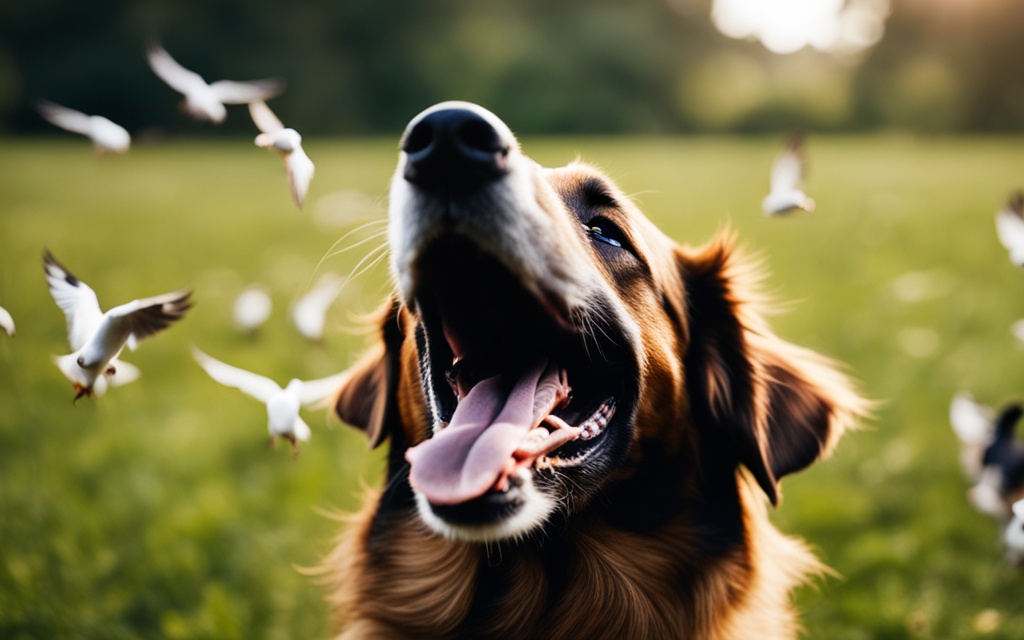
Did you know H5N1 bird flu viruses were found in some domestic animals, like cats, in different countries? These include Thailand in 2004, Northern Germany in 2006, and Poland plus South Korea in 2023.1 Cases of bird flu have also appeared in North America in animals like cats, dogs, goats, and cows.1 This makes us think about how bird flu can affect dogs.
The virus for avian influenza hits wild water birds like ducks, and geese the hardest, and also poultry. Some types of bird flu can infect other animals too, like mink, domestic cats, dogs, and even zoo animals.2 This way of spreading the virus raises concerns for pet owners.
A recent study showed something interesting about dogs and bird flu. Beagles given the flu virus (H5N1) showed no symptoms but the virus was found in their breath and they developed antibodies. It was also seen that the virus could stick to parts of a dog’s airways.1 This means that infected dogs who have no symptoms might still spread the virus.1
Key Takeaways
– H5N1 bird flu viruses have been found in domestic animals during some outbreaks
– Various animals, including dogs, cats, goats, and cows in North America, have caught bird flu
– A study suggests that dogs can spread the H5N1 virus, even if they don’t show signs
– Pets have a low chance of getting and spreading bird flu, but owners need to watch out
– It’s crucial for pet owners to be aware and protect their pets during bird flu outbreaks
- Understanding Avian Influenza
- Can Dogs Get Bird Flu?
- Transmission of Bird Flu to Dogs
- Symptoms of Bird Flu in Dogs
- Preventing Bird Flu Transmission to Dogs
- Reporting and Testing for Bird Flu in Dogs
- Zoonotic Risks: Can Humans Catch Bird Flu from Dogs?
- Monitoring and Controlling Avian Influenza Outbreaks
- Conclusion
- FAQ
- Source Links
Understanding Avian Influenza
Avian influenza is widely known as “bird flu.” It’s a virus that usually starts in wild waterbirds such as ducks and geese. It can also affect domestic birds like chickens and turkeys. These viruses sometimes spread to other animals, too, including mammals like wild animals and even pets.12
What is Avian Influenza?
Bird flu is a very contagious disease that mostly affects birds. There are two main types of these flu viruses. One type is “low pathogenic,” meaning it causes less harm. The other type is “highly pathogenic,” which can be very dangerous. Viruses like H5N1, a highly pathogenic type, can make birds very sick and even cause death.2 Even though most wild birds don’t show signs of being sick, they can still spread the virus when they move around.1
Types of Avian Influenza Viruses
There are lots of different avian influenza viruses. They get their names from two proteins, hemagglutinin and neuraminidase. For example, the H5N1 virus is famous because it’s very dangerous and can infect many species, including mammals.12
Can Dogs Get Bird Flu?
Susceptibility of Dogs to Avian Influenza
Dogs are not often seen as likely to get bird flu. However, there is research that hints they could get sick if they come in contact with it. This happens even though they might not look sick themselves.3Some studies have looked into this by testing beagles with the bird flu. They found that the dogs could pass the virus to others quickly.3Even if a dog shows no symptoms, it might still help spread the virus more. This is because their breathing tubes can hold the virus.
Reported Cases of Bird Flu in Dogs
In North America, there have been some strange cases. In 2023, a dog in Canada got the bird flu from a wild goose by playing with it.3Although those cases are rare and far between, it’s not impossible for dogs to carry the bird flu.3Yet, there’s no solid proof that people easily get bird flu from their pets. But, for safety, owners should still be careful.3The real worry is if the bird flu can jump from dogs to people, which barely happens. But, two events in the U.S. showed it can happen. One was a cat’s owner getting the flu in NYC. The other was a cow in 2024.
Transmission of Bird Flu to Dogs
How Dogs Can Contract Bird Flu
Dogs can catch avian influenza (H5N1) by breathing in the virus or eating contaminated stuff. This was shared in the third source. It means they can also get sick if they sniff or eat droppings from infected birds. Or from things the birds touched.
Also, the first source warns that birds living both outdoors and indoors can spread the flu to dogs. This happens when the pet birds interact with wild birds.1
Risk Factors for Infection
The second source highlights that pets going outside might get bird flu if they come near sick birds. Or if they’re in areas where the virus is present. This is a big way the disease passes to dogs. So, keeping pets away from wild or infected birds is crucial.
Symptoms of Bird Flu in Dogs
There’s a small chance that dogs might get bird flu symptoms or avian influenza. Still, it matters to know what to look for in your pet. This includes signs of H5N1 infection in pets and understanding dog flu. What we know so far tells us a bit about how canines may respond to the virus.
Clinical Signs to Watch For
One study looked at giving dogs H5N1 flu. The dogs didn’t get hotter or clearly sick. But, a different source said that birds, including pet birds, might act differently. They could sudden die, be tired, not eat, have purple or swollen parts, make fewer eggs, have a runny nose or cough, seem off-balance, or have loose bowels.1
The study’s dogs didn’t look ill outside but might have had hidden changes. And if dogs catch the flu from regular ways, they might get very sick or die. So, pet parents must watch out. Especially, for any odd signs or if their dog met wild birds or sick poultry.
Preventing Bird Flu Transmission to Dogs
The danger from avian influenza, also known as “bird flu,” is still present. This makes it vital for pet owners and those who care for backyard flocks to be proactive. They need to follow biosecurity tips for pet owners and ensure safeguarding backyard flocks from avian influenza. Doing so can prevent cross-contamination and protect your dogs.
Biosecurity Measures for Pet Owners
The first step to protecting dogs from bird flu is keeping your pet birds, if any, in safe places. This means indoors or in enclosed outdoor areas. This keeps them away from wild birds and their droppings.1 It’s also important to wash or sanitize your hands before and after dealing with birds, especially when you move birds between places.1 And remember to keep feed, drinking water, equipment, and other supplies safe. Make sure they’re not in places where wild birds or rodents can get to them.1
To further safeguard your backyard flock, make sure strangers don’t get close to your birds. And if you think there’s an infection, tell your vet or your state’s animal health officials right away.1
Precautions for Backyard Flock Owners
For keepers of backyard flocks, the responsibility is even greater in avoiding bird flu transmission. The first step includes keeping pet birds inside or in fully closed outdoor spaces, far from wild birds and their messes.1 Also, it’s key to stay away from wild birds. Just watch them from afar instead.2
Another important point is to prevent any contact between your pets and wild birds.2 By doing all these, you can truly protect your backyard flock from avian influenza. This lowers the chance of cross-contamination to your dogs too.
Reporting and Testing for Bird Flu in Dogs
If your dog might have bird flu, it’s important to act quickly. The1 first step is to call your vet or the USDA hotline at 866-536-7593. Tell them if you’ve seen any sick birds. This includes ones in your yard or wild ducks and geese.2 Being quick to spot bird flu in birds is vital. Look for signs like sudden death or unusual egg changes.
When to Contact Veterinary Authorities
The2 U.S. Department of Agriculture is keeping an eye on bird flu in birds and pets. If your pet seems sick after being near sick or dead birds, watch yourself for signs of illness. Call your local health department if you get sick within 10 days of your pet’s exposure.1 Anyone who touches infected animals should do the same.
Testing Procedures for Suspected Cases
In a study, scientists gave beagles bird flu to see how it spreads. They checked the dogs’ noses, throats, and behinds for the virus. Using advanced tests, they could find bird flu in dogs, even if they didn’t look sick.
Zoonotic Risks: Can Humans Catch Bird Flu from Dogs?
Risks of Human Infection from Infected Dogs
It’s very uncommon, but people can get bird flu from being around sick birds, dogs, and other mammals. This happens if there is a lot of close time with the animal.4 Occasionally, it has been known to occur in the U.S. , with a cat infecting someone in 2016 and a cow in 2024.4 If you’ve been near a person or animal with bird flu, watch your health for 10 days. Look for any sickness symptoms during this time.4
Precautions for Handling Sick Pets
To be safe, stay away from sick birds and their droppings. Also, avoid any area that might have bird droppings, unless you’re wearing the right protective gear.5 The flu can move from birds to other animals, including us, when we touch or walk on contaminated spots.5 This happens when we come into contact with infected birds or their waste.5
Monitoring and Controlling Avian Influenza Outbreaks
Surveillance Programs for Early Detection
The USDA tracks the spread of avian influenza through detailed records. They keep track of where the disease is found, such as in wild birds and in different types of flocks. This info is critical for finding and stopping the spread of the disease fast.6 With many cases found in pet bird flocks and small poultry farms,1 all owners are advised to watch for outbreak news near them.
Containment and Control Strategies
To stop the virus from spreading in affected areas, certain steps are essential. The most important one is to keep birds away from wild birds. It’s also key to clean the area and bird equipment often and to quickly tell authorities if any birds show signs of being sick.1 Taking these steps helps prevent the spread of H5N1 avian influenza and protects both the birds and people in those areas.7
If anyone has been around sick birds or thinks they might have, they should let health officials know right away.7 Early information helps officials react quickly to keep the disease from spreading to humans and protect everyone’s health.
Conclusion
Dogs can catch avian influenza (H5N1) viruses but might not seem sick. Research shows dogs can get the virus without getting sick right away.8 They can also pass the virus to others without showing any symptoms.8
In 2004, a dog in Thailand died from H5N1. It got the virus from eating an infected duck.9 This virus has moved from birds to people and other animals in many places.9 It’s important to watch out for any dangerous bird contact to keep pets and other animals safe. We must be careful and protect our pets and birds from the flu.89
Staying informed and alert helps keep your pets safe. Follow what the vets say to protect your pets from the flu. By being cautious, you can reduce the flu’s risk for your pets.89
FAQ
Can dogs get bird flu?
How can dogs contract bird flu?
What are the symptoms of bird flu in dogs?
How can I protect my dog from getting bird flu?
What should I do if I suspect my dog has bird flu?
Can humans catch bird flu from infected dogs?
Source Links
- https://www.cdc.gov/flu/avianflu/avian-in-other-animals.htm
- https://www.avma.org/resources-tools/animal-health-and-welfare/animal-health/avian-influenza/avian-influenza-companion-animals
- http://inspection.canada.ca/en/animal-health/terrestrial-animals/diseases/reportable/avian-influenza/animals-susceptible-h5n1-hpai
- https://www.who.int/news-room/fact-sheets/detail/influenza-(avian-and-other-zoonotic)
- https://www.cdc.gov/flu/avianflu/virus-transmission.htm
- https://www.cdc.gov/flu/avianflu/hpai/hpai-interim-recommendations.html
- https://www.who.int/news/item/12-07-2023-ongoing-avian-influenza-outbreaks-in-animals-pose-risk-to-humans
- https://www.ncbi.nlm.nih.gov/pmc/articles/PMC2828096/
- https://www.ncbi.nlm.nih.gov/pmc/articles/PMC3372347/











